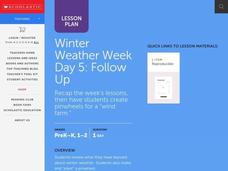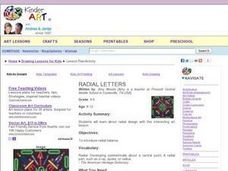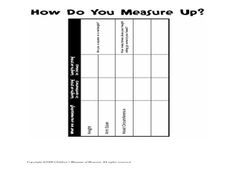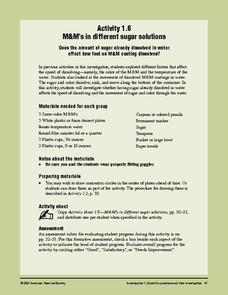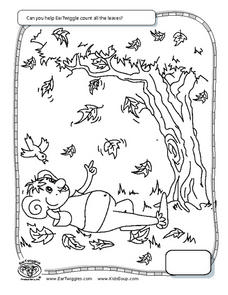Curated OER
Moving and Grooving with Tempo:
Young scholars are able to repeat various movements. They are able to state the definition of tempo. Students are able to distinguish between a slow temps and a fast tempo. They form a circle and play the music detective game.
Curated OER
From One End to the Other
Seventh graders trace a piece of food through the alimentary canal and differentiate between mechanical and chemical digestion in several different hands-on activities related to digestion.
Curated OER
Winter Weather Day 5: Follow Up
Students participate in culminating activities for a winter weather unit. They discuss what they have learned about winter weather, and write a diamante poem using winter vocabulary words. Students also construct a pinwheel and explore...
Curated OER
Making Sense Of A Round World On A Flat Surface
Students engage in a lesson that is concerned with the development of geography skills. They take part in a number of activities that center around finding and traveling to different locations. The lesson has resource links that can be...
Curated OER
Webs and Spiders
Students see how a spider spins her webs. They use yarn, pipe cleaners, eyes and glue to make the spider. For the web, students stand in a circle. They throw the ball of yarn across the circle. This begins the nice web shape. Students...
Curated OER
Hot Hamsters
Using this quick activity, you can have your class review what they have learned about mammals. Learners sit in a circle, and take turns naming a mammal. This activity could be enriched by having learners go to their desks, identify a...
Curated OER
Intersecting Lines and Segments of Measures
Mathematicians measure intersecting lines-and circles, and create chords. In this geometry lesson plan, learners explore interrior and exterior chords created by tangent and secant lines. These segments can be inside the circleor outside...
Curated OER
Star Master Viewer
Students construct the viewing tubes by cutting along the designated line shown on the template, rolling the paper into a tube, and taping the tube securely. Next they cut out the cardstock circles - the StarCards cutting on the outside...
Curated OER
I've Never Tried That - Present Perfect Tense
Students choose three items from a list and discuss the cultural importance of each one. They complete a chart, research information, create a presentation and share it with their peers. Students choose activities to in which to...
Curated OER
Money
Students examine ten pennies on their mats as they tell what they know about them. They follow verbal directions that are given by the teacher to count out specified numbers of pennies. They repeat the activity with dimes and talk about...
Curated OER
Happy Birthday Martin Luther King
First graders listen to the book Happy Birthday Martin Luther King and sing a song about him. In this reading lesson, 1st graders develop listening skills as they listen to the book. They also discuss their feelings about the laws that...
Curated OER
Blow and Go
Learners discover how air can move things by using their breath. In this physics lesson, students hypothesize then attempt to move a pencil 1 meter using nothing but their breath. Learners record data from their experiment including...
Curated OER
Wheeling Around
Eighth graders explore the characteristics of a circle and the formulas to find circumference. They use a bicycle wheel to determine the circumference around a wheel. They utilize a worksheet imbedded in this plan which has a variety of...
Curated OER
Discovering Pi
Fourth graders are introduced and experiment with the concept of pi. Using this information, they discover the relationship between the circumference and diameter of circles. In groups, they practice measuring the circumference of...
Curated OER
"Slice of Pi with Neo-Excel"
Students explore diameter, radius, and circumference. They define radius, diameter, and circumference on an online dictionary, identify objects in the room with a radius and a diameter, and calculate the radius and diameter of various...
Curated OER
"Graph It"
Students work in teams to conduct short surveys of their classmates. They show their results using at least two different types of graphs.
Students separate into teams and are asked that each team to choose something that they are...
Curated OER
Comuter Technology-Applying Spreadsheet Information
Students create spreadsheets and practice sorting within the spreadsheet with three different activities. Students manipulate different materials such as addresses, real estate sales, and athletic participation numbers.
Curated OER
Radial Letters
This art lesson seems simple enough. As a way to introduce radial symmetry, spokes, or rays, learners create an artistic representation demonstrating radial symmetry. They stick a variety of letter stickers on their paper starting in the...
Curated OER
How Do You Measure Up?
Young scholars measure their body. In this measurement lesson, students use a string to measure their height and the circumference of their head. They record this information on the worksheet provided and answer questions as a group.
Illustrative Mathematics
Toilet Roll
Potty humor is always a big hit with the school-age crowd, and potty algebra takes this topic to a whole new level. Here the class develops a model that connects the dimensions (radii, paper thickness, and length of paper) of a common...
LABScI
Photosynthesis: How Do Plants Get Energy?
Examine the mechanism of photosynthesis through different light scenarios. Pupils vary the amount and type of light exposure on plant leaves in the fifth lesson plan in a 12-part series. Through observation, they determine the rate of...
American Chemical Society
M&M's in Different Sugar Solutions
To conclude a mini unit on the dissolving of M&Ms® candy coating, this activity investigates whether or not the concentration of sugar in the solvent affects the dissolving rate. Consider having older science learners write their own...
Curated OER
EarTwiggle
In this counting leaves worksheet, students assist EarTwiggle in counting all the leaves found within a piece of art and then place their answer in the box provided at the lower right hand corner.
Laboratory for Atmospheric and Space Physics
The Planets and Scale
Scholars gain an insight into the relative size of planets and distance between inner and outer planets with the help of informational text, a data table, and a series of four questions.




